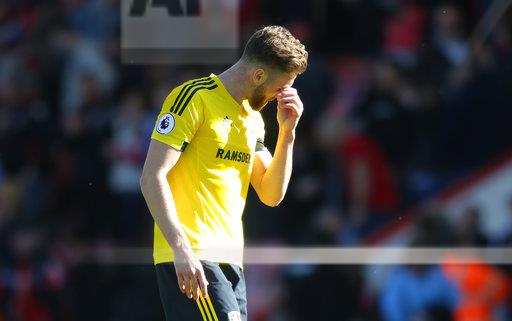Last season, Calum Chambers would have been excused for believing his Arsenal career was shot.
At the age of 22, players should be making headway with their current squad and attaining valuable game time.
Chambers, however, had been usurped by fellow Englishman Rob Holding – who cost a fifth of the fee Arsenal paid for the Southampton man in 2014.
It is disappointing the 22-year-old left the club on loan. In his first season at Arsenal, he put in some fine performances at centre-back, looking assured on the ball, dependable in defence and appeared an excellent reader of the game.
However, games at right-back and some unconvincing performances in central defence punctured Chambers’ confidence – of which he has struggled to recover.
Wenger is clearly a fan of the young English defender. But with Gabriel Paulista, Laurent Koscielny, Shkodran Mustafi and Holding all ahead of him in the pecking order at the start of last season, the Arsenal manager sent Chambers to Middlesbrough.
It seemed a smart move. The North-East club’s ambition to stay in the Premier League saw them adopt a defensive mentality. Chambers’ natural talent ensured he would start regularly and then-manager Aitor Karanka saw enough in the young Englishman to build the defensive unit around him and Ben Gibson.

The two defenders complemented each other and formed a formidable partnership that almost kept them in the Premier League. By the end of the year, Chambers had ended the season as the highest rated player at the club according to WhoScored.com.
His stats from last season are notable. Chambers won, on average, 2.6 aerial duels per game and recorded an impressive 7.3 clearances per game. Those figures are not dissimilar to Rob Holding’s statistics.
Away from the penetrating light of the Emirates, Chambers has regained confidence and become a leader.
The question is, can he return to Arsenal in a similar capacity?
If Arsene had persisted with a back four, my answer would have been a resounding no. At this level, Chambers lacks the mobility and pace to be one half of a pairing. If his reading of the game was better, then you could make an argument for his lack of pace. However, sitting on the bench at a major club would not have developed his tactical judgement.
Since adopting a back three, Chambers’ lack of pace has become far less of an issue. Mertesacker’s performance against Chelsea in the FA Cup final demonstrates how each individual’s weakness in the trio is compensated by another’s strength.
Mustafi and Holding are aggressive. They use their weight and stature to put players off. Koscielny is a front-footed defender – he likes to steal the ball before the opposing player has it under control. Mertesacker is a reader of the game – he sits back and stations himself strategically. Monreal is disciplined and competitive whilst being competent at reading and tackling.
I believe if Holding had played more games as a duo, he may not be receiving as much praise as he is currently. I also feel that Mertesacker would not have been as fantastic as he was on the FA Cup final if he hadn’t been playing in the sweeper role behind the more agile Holding and Monreal.
Chambers is unlikely to start next year. In order to do so, he will have to leapfrog one of Koscielny, Mustafi and Holding (and that’s without considering Monreal as a centre half – which I believe Wenger will).
Yet with three positions, four competitions and the need for rotation, Chambers will be utilised on a regular basis – possibly alongside Gabriel and Mertesacker in the Europa League and early stages of the domestic cups.
Chambers once looked an exciting prospect. In the years since his debut, he has undoubtedly struggled. Yet, he still has the attributes and talent to become a very useful and, dare I say it, accomplished defender.
Will Chambers have a long and fulfilling Arsenal career? The answer right now is; who knows? The journey will be long and arduous. But there is hope. If you’d asked the same question last year, the answer may not have been as positive.

